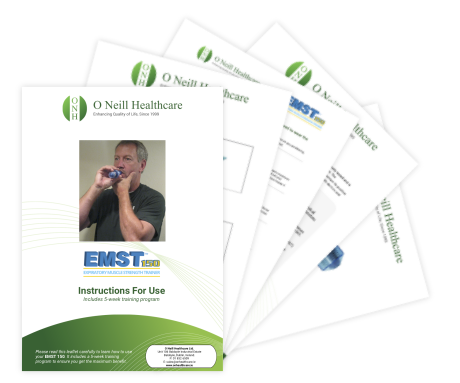Due to the growing popularity of the EMST150 (Expiratory Muscle Strength Trainer) amongst physiotherapists and other healthcare professionals, we have decided to put together this article answering some of the main questions about respiratory muscle strength training.
What is respiratory muscle strength training?
Respiratory muscle strength training programs are exercise-based programs that work to strengthen the muscles used in breathing.
Leith and Bradley (1976) first demonstrated in healthy individuals that the respiratory muscles, like their skeletal muscle counterparts, could be specifically trained to improve strength or endurance. Over the years, it has been found that these programs help other functions, like speech, cough and swallowing.
The programs can be either inspiratory or expiratory and are typically accomplished using handheld devices. Training durations typically are 4-8 weeks. Training trials usually take 20-30 min per day.
What is the EMST150 device?
EMST stands for Expiratory Muscle Strength Training and the EMST150, from Aspire, is a device that was developed to help strengthen the expiratory muscles used for breathing. It has a pressure range that goes to 150 cmH20, which is why call it the “150.”
Why use the EMST 150?
Training with the EMST 150 is a simple way to strengthen the expiratory/exhalatory muscles in a short period of time. There is no machine at the gym or health club that can accomplish this for you. If you are in need of improving the power and endurance of your breathing, the EMST150 can do that for you simply and efficiently.
In a healthcare setting, Due to its ability to strenghten the muscles involved in coughing, swallowing and breathing, the EMST150 is used in the healthcare industry to address symptoms of neuromuscular diseases such as Parkinson’s, Multiple Sclerosis, Huntington’s ALS and as well as for Dysphagia, Stroke and COPD.
Is there research supporting the use of the EMST 150?
In short, yes.
Aspire, the creators of the EMST150, have been studying respiratory muscle strength training outcomes since the late 1990’s. They started investigating how it could be used with patients that have limited glottal airway space. From there, their work moved to others with muscle weakness including multiple sclerosis, spinal cord injury etc.
Their latest work has focused on patients with Parkinson’s disease. The largest randomized clinical trial on EMST is published in Neurology(2010). In this work, they found positive outcomes for variables related to airway protection.
For more clinical data on the EMST150, click here to download our EMST150 Toolkit.
Can everyone use the EMST 150?
There are certain contraindications for the use of the EMST 150TM, so patients are always encouraged to discuss the program with their physician. Some of the contraindication include occurrence of acute stroke, untreated hypertension, untreated gastroesophageal reflux and pregnancy.



